Are you looking for a guide on how to drain a GE dishwasher? A non-draining dishwasher can become problematic for its owners. GE has designed its dishwashers to remove the wastewater from the tub at the end of the cycle. If this doesn’t happen, your dishwasher will not start another cycle.
But if you find an excess amount of water in the tub after the wash cycle, it is a clear indication that your dishwasher’s drainage mechanism is not working correctly.
But don’t worry. I am here with this guide to help you find the causes and solutions to the drainage problems with your dishwasher.
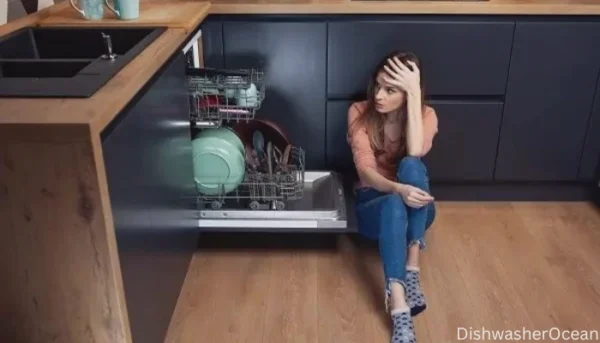
What causes drainage issues on GE dishwashers?
There can be many reasons that can cause drainage issues on your GE dishwasher. Most of the time, the reason behind your dishwasher not draining is large food particles and debris that cause clogging and discourage water flow.
These food particles and debris block the drain hose and filter of the dishwasher, leading to drainage issues. Also, ventilation plays a vital role in the draining process. Make sure to have a high loop and working Air gap to avoid any disturbance.
Apart from these reasons, there are some technical reasons that disturb the drainage mechanism, like drain pump failure and issues with drain solenoid.
How can I fix the drainage issue on my GE dishwasher?
To fix your non-draining dishwasher, you will only be required to read and follow the given below instructions. I have explained each of the causes with their troubleshooting steps.
Don’t use much detergent.
If you are using limitless detergent in your dishwasher, then stop it immediately. Adding too much detergent will create too many suds that will disturb the draining process of your dishwasher.
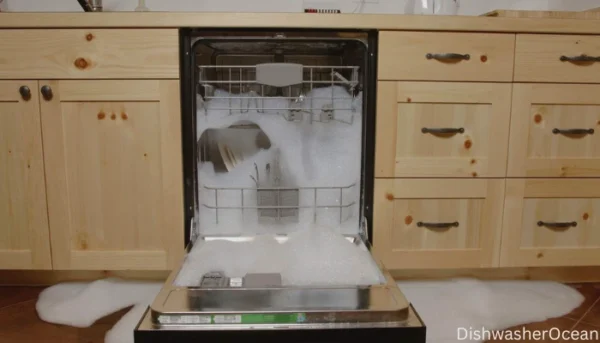
According to the manufacturers (GE), detergent usage depends on the dish’s soil level and water hardness level. You should refer to your dishwasher’s user manual to find the amount of detergent your dishwasher needs.
Check the drain pipe.
A blocked drain pipe is one of the common reasons for drainage issues in your dishwasher. The drain pipe is basically a tube that connects the dishwasher to your garbage disposal. It can get clogged by food, fat, grease, or any other obstacle.
Pull out your dishwasher and turn it back to access the drain tube. You will find it connected to your sink disposal. You will need to detach it from there and check it properly for blockage and damage. Use a wire or something that can get into the tube to remove the obstacle.
In case of a damaged tube, I would highly recommend replacing it with a new one. Once you have done these, reconnect it, start your dishwasher, and check if the issue is fixed. If the issue is still persisting, check out the other solutions.
Fix garbage disposal issues.
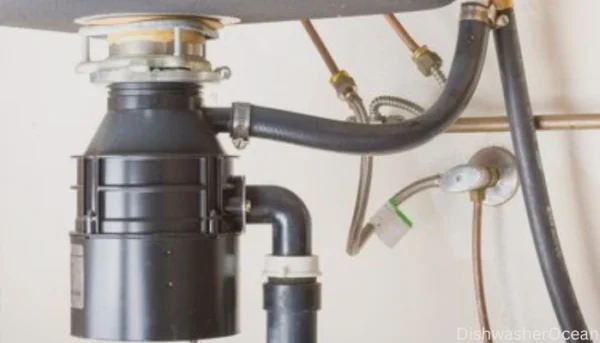
One end of the drain pipe connects to the garbage disposer. It helps to break down the larger food particles so that they can flow easily in the tube. If the garbage disposer is defective it can cause blockage and drainage problems.
Open the garbage disposal and clear all the debris from it. If your dishwasher is newly installed, ensure the garbage disposal knockout plug has been removed from the drain tube.
Examine the Air gap.
If your dishwasher’s drain hose is connected to the air gap, you should check there for a clog. The air gap fitting is attached to the sink or cabinet of the kitchen.
It is used to prevent the backflow of wastewater in the dishwasher. If the air gap is clogged, the wastewater will flow back to the dishwasher, preventing the dishwasher from draining.
It works by transferring air to the hose, which removes the negative pressure from the hose that can cause drainage issues. Remove the air gap cover and clear all the debris from it to fix this issue.
High loop

A high loop is another method to prevent the wastewater from returning to the dishwasher. In this method, we position the drain hose loop so high that the water will not flow back to the dishwasher.
If your loop is not high, the discharged water will start flowing back, causing excess water at the bottom of your dishwasher. So, set your loop high to avoid drainage issues.
Unclog the sump and filter.
The sump and the filter are both found in the bottom of the dishwasher. Both of them play a significant role in the draining process.
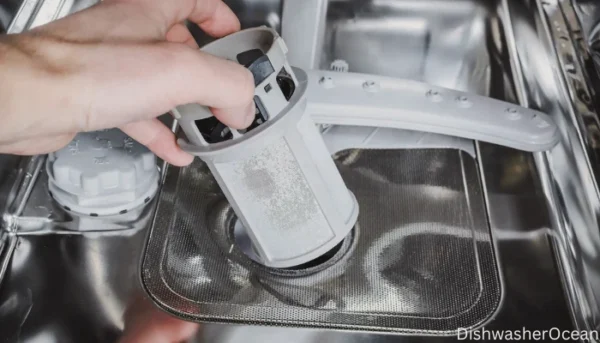
The dishwasher filter cleans out the large food particles or debris from the water so that the internal parts can stay away from being clogged, whereas the sump collects the water for the drain pump and helps control the flow of water into it.
If any of them get blocked, the dishwasher will not drain. Most of the filters of GE dishwashers are removable, but before inspecting the filter, make sure that the power of your dishwasher is off.
Now, remove the filter and clear all the debris from it. Wash it with warm, soapy water to clear all the obstruction or mineral build-up.
The sump is found under the filter basket of the dishwasher. Reach there and clean all the debris and food waste to unclog it.
Check the drain hose
Another reason for drainage issues is a kinked, blocked, or damaged drain hose. If your drain hose is kinked, set it right using your hands or any tool. And if your drain hose is blocked, you have to remove that clog.
Detach the one end of your drain attached under the sink carefully and inspect it for an obstacle blocking the way. You can use a drain snake tool or any other tool to remove that obstacle.
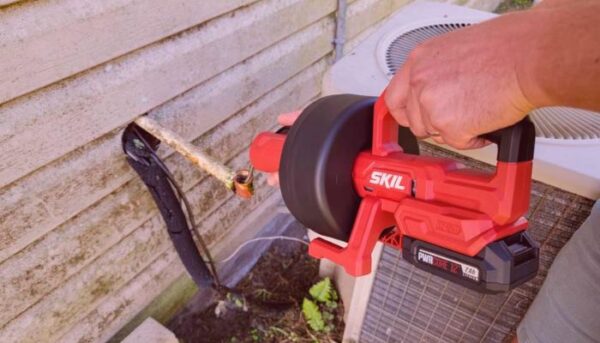
If the obstacle in the dishwasher drain hose is not visible or not reachable, you can consider this another technique. In this technique, we will try to flush out the obstacle by running the dishwasher for a short duration. To do so, Follow the steps provided below:
- First, put that detached end into a bucket to avoid a dirty floor.
- Now, start running a cycle and look into the bucket.
- Wait for that obstacle to come out and stop the cycle afterward.
In case of damage, replace the drain hose with the help of a plumber.
Repair the drain pump
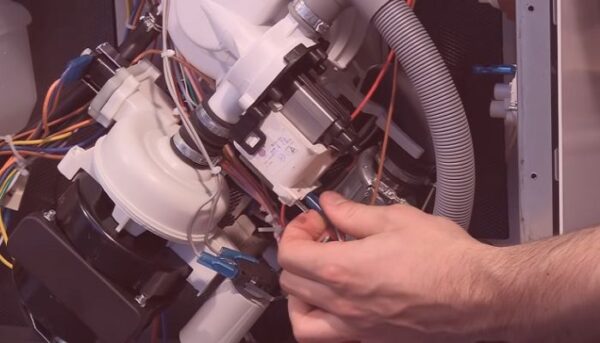
If you have tried all of the above and the dishwasher still has the same issue, you must check your dishwasher’s drain pump at once. In the whole draining process, it is a pump that removes all the wastewater from the dishwasher. None of the troubleshooting steps will work until the pump is malfunctioning.
The pump failure can be caused by two reasons, one technical and the other electrical. The technical reason behind the pump failure is a damaged pump impeller. The pump impeller is a rotating disk of plastic or steel attached to the pump. It rotates to pump out the water in a specified direction.
Follow the below steps to test your pump impeller:
- Power off your dishwasher and turn off the water supply for your safety.
- Next, remove the lower panel of your dishwasher to access the drain pump.
- Identify the drain pump and attach the pump impeller to it.
- Now, try to rotate the impeller by your hand. Avoid forcing the rotation, as it can cause further damage.
- If it is not spinning freely, you will need to replace the damaged impeller with a new one.
To check if the drain pump failed electrically, take your multimeter and follow the steps given below:
- Turn off the power supply and water supply to the dishwasher.
- Identify the drain pump behind the lower access panel.
- Now, turn on the dishwasher power and check the electrical continuity of your drain pump using a Multimeter.
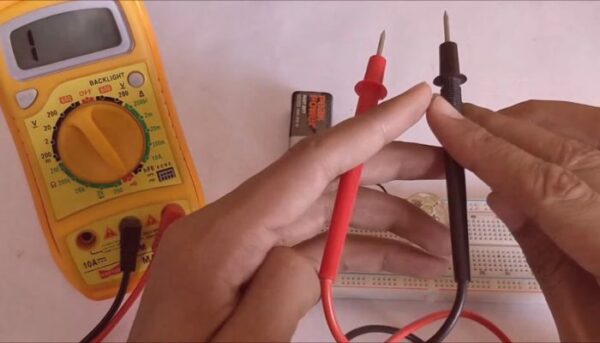
- A fully functional drain pump should have a resistance somewhere around 200 ohms.
- Remember to disconnect the power after completion of the test.
- If your drain pump fails the electrical test, reassemble the dishwasher and ask a professional to replace it.
Inspect the drain solenoid.
Most GE dishwashers have a drain solenoid that opens up the drain valve, allowing the removal of dirty water from your dishwasher. If the drain solenoid is broken or starts malfunctioning, the drain valve of the dishwasher will not open, resulting in the GE dishwasher not draining.
To resolve this issue, we have to conduct an electrical continuity test of the drain solenoid using a Multimeter and replace it if it is found faulty.
Follow the given steps to run the test.
- Begin by turning off your dishwasher’s power supply and water supply.
- Now, turn your dishwasher back and remove its lower access panel.
- Identify the drain solenoid located on the drain pump.
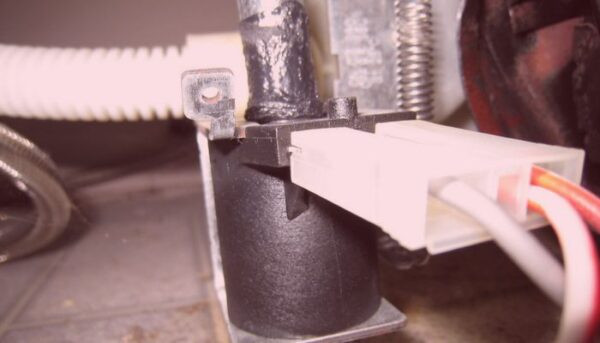
- Now, restore the dishwasher’s power and check its electrical continuity.
- If your drain solenoid is working, the multimeter will show a reading between 15 to 40 ohms.
- If you find it faulty, you should immediately replace the defective drain solenoid and check to see if your dishwasher is draining properly.
How can I force the drain on my GE dishwasher?
Before jumping onto solving the causes of the drainage issues, you will need to remove that extra amount of water pooling at your appliance’s bottom.
Here are the instructions for forcing your GE dishwasher to drain immediately.
- Press the start button of your dishwasher for three seconds.
- It will start the force drain on your dishwasher, and you will hear draining sounds from the dishwasher.
- Now, you will need to wait till the dishwasher completes the drain.
- Open and check your dishwasher after the completion of the drain cycle dishwasher.
- If there is still some water at the bottom, repeat the same process until it drains completely.
If your dishwasher is in mid-cycle and you want to drain it, you have to cancel the cycle first. Here are the steps that you will need to follow.
- Many GE dishwasher models have a Stop/Pause or Cancel button. Press that if you have one.
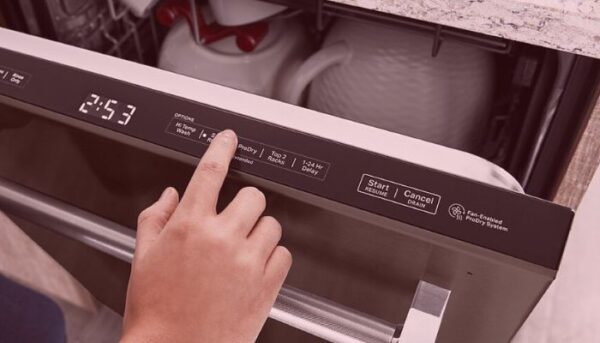
- If your dishwasher does not have these buttons, then open your dishwasher door slightly to stop the cycle.
- Make sure that the sprayers have stopped spraying.
- Now, open the dishwasher door completely to access the control panel.
- Press and hold the Start or Reset button for 3 seconds to start the force drain cycle.
If none of these methods are working for you and water is still not draining from your appliance, you should drain it manually.
To do so, remove all the utensils from the dishwasher and turn off its water and power supply. Now, use a cup of mug to remove all the water from the dishwasher tub. If the standing water is too much, you can also get help from a Dry/Wet vacuum.
FAQs
How do you reset a GE dishwasher drain?
Press the Start/Reset button once. It will activate the drain pump, which will pump out the drain from your dishwasher in a minute. After that, you can use your dishwasher without any hesitation.
Is the water supposed to stay in the bottom of the dishwasher?
According to manufacturers, one or two cups of standing water in the bottom of the tub is considered normal. If the water is more than this, there must be some problem with the drainage system of your dishwasher.
Where is the dishwasher drain?
The drain hose in your dishwasher is located either under your sink or in the back of your dishwasher. It is a tube that connects your dishwasher to the garbage disposal. It is used to transfer the dishwasher’s drain to the garbage disposal.
Why do dishwasher drain pumps fail?
The main reason behind the dishwasher’s drain pump failure is a clogged filter, a damaged drain pump impeller, and a blocked drain hose. You should call a professional technician to diagnose and fix your drain pump.
Conclusion
Drainage issues with dishwashers have become common nowadays. Many people find it a daunting task, but it’s not. Some common reasons why your GE dishwasher is not draining is drain pump failure, clogged drain hose, debris filter and sump area, a faulty drain solenoid, broken air gap, and garbage disposal issues.
However, all these issues are fixable at home without paying dollars to the technician. You will only need to follow the instructions mentioned above. As I said, dishwasher issues are becoming common nowadays; you should also take some steps to avoid the problems.
Regular cleaning and maintenance can prevent most of the issues on your dishwasher so that your dishwasher will perform optimally for a longer time.
This was the complete troubleshooting guide on fixing the dishwasher that doesn’t drain. I hope you found it helpful and knowledgeable. If you have any doubts, comment below. I will be happy to assist you further.
